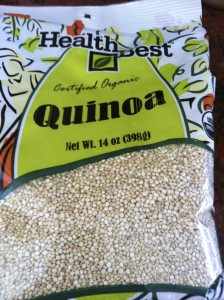
|
Time for Quinoa It’s springtime, and a good season to celebrate the tiny powerhouse known as quinoa. For the initiated and uninitiated alike, her are a few hopefully useful facts and tips. Called the “mother of all grains” by the Incas, quinoa, pronounced qeenwah, is a tiny powerhouse of nutrients. It is a native of northern South America and was a staple food of the Incas and other Indians in Peru, Ecuador and Bolivia for over 6,000 years. Only in the last few decade has this remarkable food caught on in the United States. Although it looks and cooks like a grain, quinoa is the fruit of the chenopodium family (and is closely related to beets and spinach) but only the edible seeds of the quinoa plant are generally eaten. It has the highest protein content of any grain and unlike others, is a complete protein. Besides being high in lysine, an amino acid that is scarce in other grains, quinoa is one of the few vegetarian foods with all eight of the essential amino acids. It has substantial amounts of iron, phosphorus, magnesium, zinc, vitamin E, and B-vitamins, including folate, as well. The bitter saponin coating makes it a natural repellent to birds. Most quinoa sold commercially in North America has had the saponin removed, but it is still a good idea to wash it before cooking. Since the seeds are tiny, you need to use a strainer. Place the quinoa in a bowl of water to cover by two inches. Rub it between your submerged hands, then place it in a strainer and rinse for a few seconds until the water runs clear. To make it the most digestible and bioavailable, soak it overnight with enough water to cover. Quinoa has a light pleasing texture, comes in gold, red, and black, and can be used in place of or along with other grains. It’s great to start cooking it as the weather heats up. It’s fast, light, and versatile. Cook it as a pilaf, in casseroles, and as a breakfast porridge. Quinoa mixed with herbs and vegetables makes a satisfying lunch. To cook quinoa, the basic ratio to use is two cups liquid per cup of grain. For a breakfast porridge, cook in three-to-four parts liquid to one cup quinoa. To make the fluffiest version, after you rinse quinoa, add it to a pot and dry toast the grains. Move them around with a spoon in the pot that you are going to use–just until all of the grains have dried and begun to smell fragrant, about 5 minutes. Then add your liquid, bring to a boil and add a pinch salt, cover, then lower the heat and simmer the quinoa without mixing for 10 to 15 minutes, until all of the liquid is absorbed. Little steam tunnels form while it cooks, and it is important to suppress the urge to disturb them. Instead, tilt the pot gently instead to see if the liquid has been absorbed. Each tiny yellow grain has a barely noticeable external germ that, when cooked, circles the grain like a translucent Saturn ring. The ring gives a subtly soft crunch that contrasts pleasingly with the softer part of the rest of the grain. Share on Facebook and Twitter | Grains, ingredients | No comments
Leave a Reply
|

